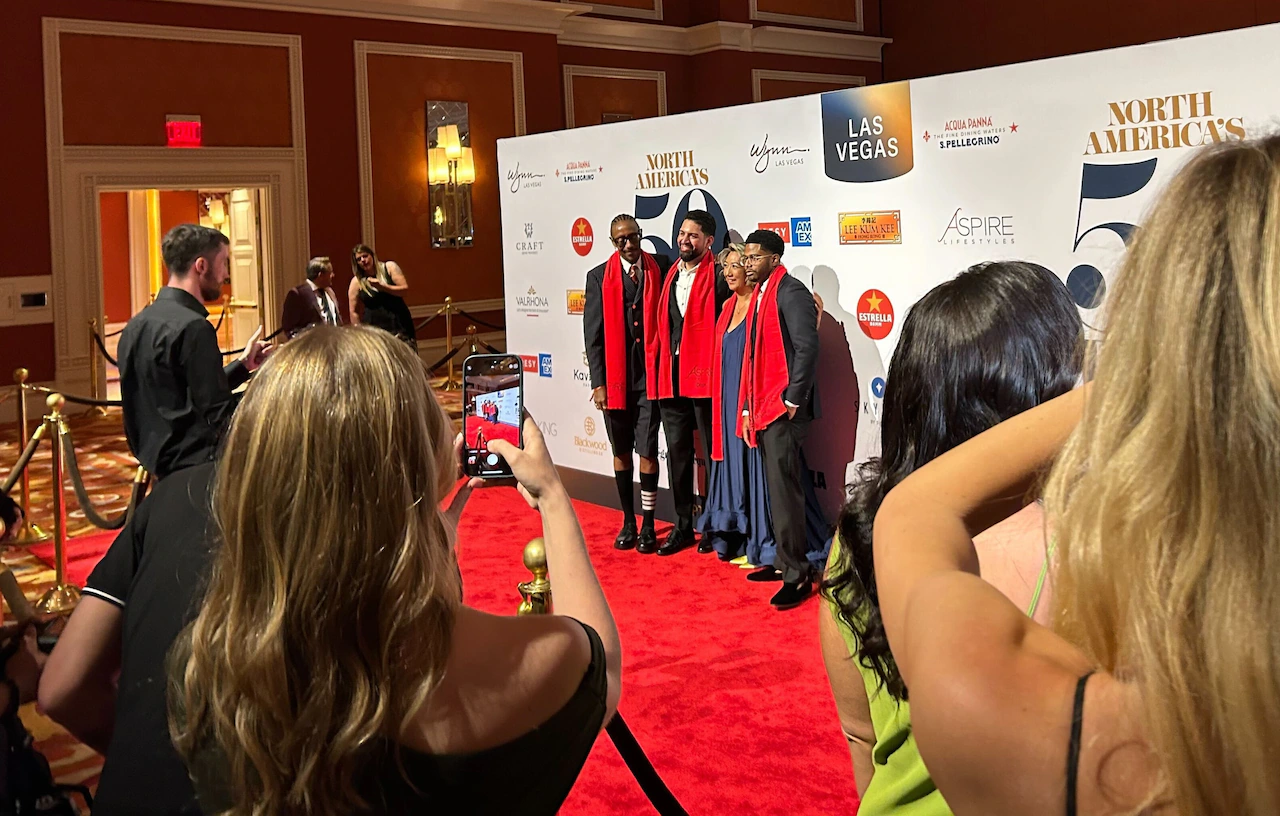
The Oregon delegation walked down a wide hallway, part of a maze of blood-orange carpets at the back of a sprawling Las Vegas hotel, heading for a restaurant to discuss bringing the 50 Best organization’s new North American restaurant awards to Portland.
Led by Mike Thelin, the Feast Portland festival co-founder, and including members of tourism bureaus Travel Oregon, Travel Portland and the Oregon Wine Board, the group’s mission was exploratory in nature: get a sense of the show’s size and scale, meet the players involved, and find out what it would take to host the event, perhaps as soon as 2027.
But executives from the 50 Best group who attended the meeting at The Cosmopolitan hotel one day before last Thursday’s awards show, suggested a counter-proposal: Get the finances in order, and the North America’s 50 Best Restaurants ceremony would come to Portland next year.
Like the movements to bring a Major League Baseball team or large-scale public market to Portland, attracting a big-deal food show is seen as a way to bring some much-needed positive attention to the city and state. At the same time, the 50 Best ceremony — and the many chefs, restaurant owners and media members likely to attend — could help shape a counter narrative to the past five years of negative press, culminating in recent days with President Donald Trump authorizing the deployment of federal troops to Portland.
“I think we all agree Oregon needs to do something,” Thelin said. “Since the pandemic, we’ve been in a place where we’ve done a lot of smaller things, and there’s nothing wrong with that. But I think there’s just a collective need with where the world is now to make some bigger moves.”
Oregon tourism officials are meeting this week to discuss the feasibility of raising nearly $2 million to bring the event to town, or whether that money might be better spent elsewhere. To that end, a smaller Oregon delegation flew from Nevada to California to attend Terra Madre, a slow food conference typically held in Turin every other year but which launched its first North American event in Sacramento last weekend.
Tourism officials stress that 50 Best isn’t their only iron in the fire and that no decision has been made regarding bringing the event to Portland.
But the pressure is on. At least three other delegations made the trip to Las Vegas last week, insiders say, including Montreal and New Orleans, all places that landed more restaurants on the inaugural North American list than Oregon. And 50 Best doesn’t want to hold its next North American awards a year from now. It wants to hold them in May.
“The big thing to underline is that we’re really in an information gathering phase right now, just to see what these global events are like,” Travel Oregon Director of Communications Julia Amato said Friday. “That said, we recognize the opportunity in front of us and that we have to act fast.”
“We just can’t wait”
As local makers presented Oregon-grown hazelnuts, Oregon-pressed olive oil and Oregon-made sea salt and chocolate at the Terra Madre festival a few days after the 50 Best meeting, Portland became the top news story in America — and not for the reasons tourism officials typically desire. Weeks after threatening to send federal troops to “wipe out” the relatively subdued protests outside the federal immigration building in South Portland, Trump on Saturday authorized sending federal troops to Oregon to protect what he described, hyperbolically, as a “nightmare” and “war zone.”
Though many locals met that characterization with derision, the fact remains that tourism remains down from pre-pandemic levels. Officials with Travel Portland and Travel Oregon think a multi-day food show like North America’s 50 Best Restaurants or the James Beard Foundation Awards could start to change the national perception of the region.
“Frankly, we just have to do something,” said ChefStable restaurateur and new Travel Portland board chair Kurt Huffman, who attended the Las Vegas event and meeting. “We can’t just wait around for all the good feelings about the Portland food scene to come back.”
Tourism officials declined to discuss specific financials. But according to three people with knowledge of the meeting, who spoke on the condition of anonymity so as not to undermine the negotiations, 50 Best asked for $1.6 million for a two-year commitment, a discount on the $1.2 million per year the delegation had been expecting. That’s around the same cost Travel Sacramento spent to host Terra Madre, sources say, and less than the approximately $2 million it took to bring “Top Chef” to Portland for a 2020 season marred by coronavirus lockdowns.
That figure won’t all come from local tourism bureaus. And it could be lowered via private sponsorship of travel, hotels, food and venues for the show and its various dinners, talks and after parties.
“I think people with money in Portland are aware that the huge decline in tourism is putting an impact on the city’s coffers,” Huffman said, “and they’re willing to put their own money into initiatives that tell a different story than the one that people have been seeing on Fox News for the past few years — or apparently the ones that President Trump has been watching.”
Unlike the anonymous inspectors behind the Michelin Guide (which local tourism executives have also discussed paying to bring to Portland), the 50 Best organization does not pay for its voters’ meals, and has never prohibited accepting free meals and trips. In practice, that has meant deep-pocketed tourism boards have been able to impact the 50 Best voting system, in which judges are asked to list the “best” meals they ate in the past 18 months, by hosting the annual show, funneling known voters to top restaurants for comped meals while they’re in town.
That strategy has paid off for the culinary reputation of some cities, including New York and Melbourne, where restaurants rose in the global rankings or joined them for the first time one year after each hosted the World’s 50 Best Restaurants ceremony. In Peru, where the national tourism board has been particularly aggressive in wooing 50 Best voters, two restaurants have risen to the No. 1 spot in recent years: Central in 2023 and Maido this year. Thelin and Travel Oregon Destination Services Director Scott Bricker each attended that most recent global ceremony in Turin, Italy.
“Like the NFL Draft”
Launched by the British magazine Restaurant in 2002, the World’s 50 Best Restaurants list has gone from a scrappy roundup of random food-writer favorites to a global powerhouse, driving international tourists to restaurants from Paris to Tokyo to Lima, Peru. Long sponsored by the Nestlé-owned Italian water company S.Pellegrino, the list has grown into what GQ Magazine in 2016 called “the most powerful, most anticipated ranking of its kind … even eclipsing the Michelin Guide.”
Thelin, whose consulting company holds an $85,000 contract with Travel Oregon, compared the World’s 50 Best Restaurants ceremony to the NFL Draft, saying that it brings together “the top chefs in the world, the top media, and creates a critical mass.”
Kann — the wood-fired Haitian restaurant from Portland chef Gregory Gourdet, who also attended Wednesday’s meeting — was the lone Portland representative on the inaugural North America’s 50 Best Restaurants list, which recognizes restaurants from the United States, Canada and parts of the Caribbean, but not Mexico.
But insiders expect the North American guide to follow 50 Best’s ever-expanding global restaurant and bar lists — and its regional guides to Asia and Latin America — by growing from a top 50 to a top 100 in the coming years. That could open up more slots for some of Portland’s other great restaurants such as the Thai tasting menu destination Langbaan, the ambitious neighborhood bistro Coquine, and the creative Japanese restaurant Nodoguro.
Today, in addition to its flagship global list, the 50 Best group arranges black-tie galas for its guides to the world’s best bars and restaurants in four distinct regions, with North America joining Asia, Latin America and the Middle East this year. Five American restaurants made the list’s global edition announced at the Turin ceremony in June: Atomix (No. 12), Le Bernardin (No. 80) and César (No. 98) in New York; and SingleThread (No. 80) and Atelier Crenn (No. 95) in California.
According to the organization, 50 Best voters are given no criteria whatsoever for defining “best.” For North America, Academy chairs in each of eight sub regions selected panels of around 300 voters that included “food writers and critics, chefs, restaurateurs and well-travelled gourmets.” The global list has around 1,100 voters.
“Too white, too male?”
Historically, that system has produced a list that has been frequently criticized for being too white, too male, too Eurocentric, too vulnerable to manipulation and cronyism and too obsessed with ultra-expensive tasting menus so avant garde as to be off-putting to even well-traveled diners.
By contrast, the initial North America’s 50 Best Restaurants list was both more diverse — in terms of cuisine — and more casual. Take Kann, Gourdet’s wood-fired Haitian hotspot at 548 S.E. Ash St., which landed at No. 27. Though undoubtedly a special occasion restaurant for Portland, with most mains priced between $45 and $69, Kann features an a la carte menu and allows walk-ins, assuming reservations aren’t fully booked for the night. According to Gourdet, those walk-ins have been up since Thursday’s awards.
But as with the global awards, the vast majority of winners on the North American list were men. The organization has attempted to offset this issue by handing out a Best Female Chef trophy each year, an award that has itself been widely criticized for sexism, including by several former winners.
50 Best spokesperson William Drew, who attended last Wednesday’s meeting with the Oregon delegation, has argued that anger toward 50 Best’s gender imbalance is misplaced: “This is a case, I think, of us reflecting society on the whole,” Drew told GQ in 2016. “You can be mad at the restaurant industry, perhaps, but not at us.” Two years later, the organization increased its share of female voters to a 50/50 gender split.
Meanwhile, geographic diversity was an issue for the new North American list. Most restaurants were concentrated in large cities, with New York (13 restaurants, or 26% of the list), Canada (11, or 22%, including five in Montreal and two each in Toronto and Quebec) and California (10, or 20%, primarily in San Francisco) gobbling up fully nearly two thirds of the available spots. Meanwhile, Philadelphia and Washington, D.C., landed three restaurants each, while Chicago, New Orleans and the Caribbean each grabbed two. That left four spots for the rest of the United States: Charleston, Denver, Nashville and Portland each claimed a spot.
Stories by Michael Russell
Portland is America’s second best foodie city, study says. See who ranked first
Portland restaurant named to inaugural North America’s 50 Best list
The 15 cheeseburgers every Portlander should know
“We can handle it”
At the inaugural North America’s 50 Best Restaurants ceremony Thursday, chefs draped in the bright red scarves given to winners filed out of an intimate theater at the Wynn Las Vegas accompanied by their teams, food media, voters and other assembled attendees — 700 in all — then walked down several long hallways to XS Nightclub.
There, a DJ played loud music while showgirls in feathered dresses stood by stations serving charcoal-grilled beef, fresh-made sushi and a small-scale chocolate replica of the Wynn and its various sister hotels and casinos.
The presentation was dramatic, but — to put my restaurant critic hat on for a moment — the food wasn’t that great. And most chefs on the ground seemed to think the parties themselves were fairly dull.
“There’s this whole question of the infrastructure, but we went to Turin and threw a rager,” said Gourdet of the Italian city roughly the same size as Portland. “And we’ve held Feast. This is not as big as Feast. We can handle it.”



